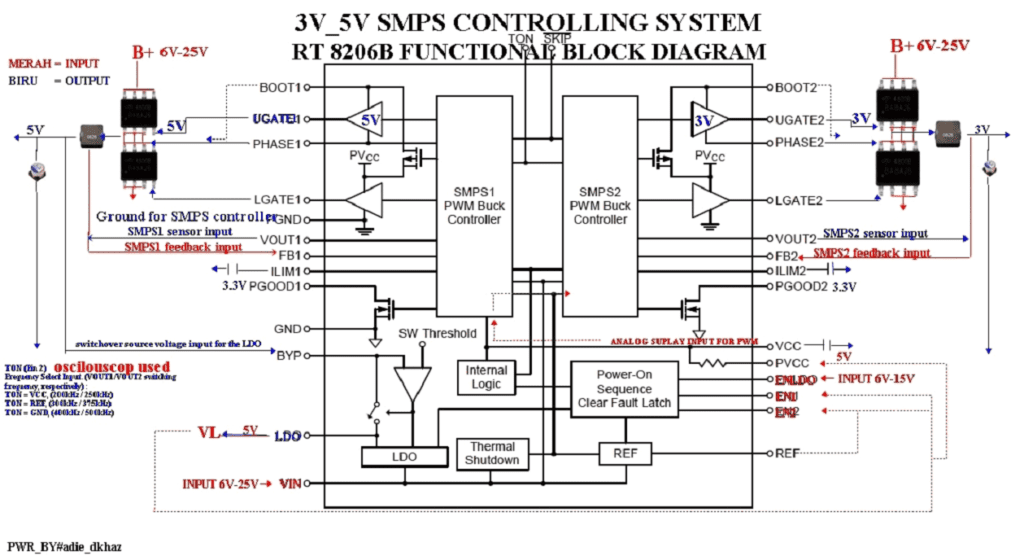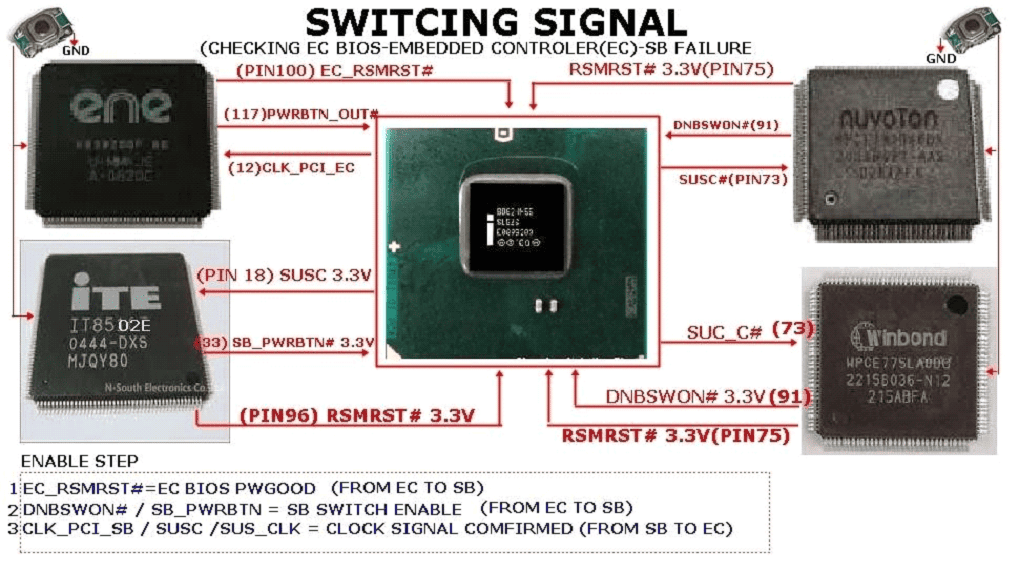The flow starts from the VIN pin which injects voltage into the laptop. The voltage at this point may vary from 18 volts to 20 volts. There are different laptop SMD and Non-SMD components present on the schematics. We are going to see the most common problems in depth to solve them.
Checking the problem by the Symptom:
Service log is made by technicians to make a record of faulty motherboard electricity and signal system , every single voltage and signal measurement are notice in this log.To narrow the search of missing voltage and signal.

Dead motherboard:
no led indicator at all, no fan moving ,no power .This mother board require an adapter voltage (12V_15V_16V_18.5V_19V_20V) also 3V and 5V to completely VALW power supply need. without this impossible motherboard to a life.
Starting with checking power jack to ensure adapter continuity supply P channel mosfet transistor ended to P channel mosfet transistor for battery fet.This line power contribution called Main circuit line of VALW power supply.Open schematic (ensure match motherboard and schematic code)for charger IC page and trace started from DC jack to adp P channel mosfet (or same motherboard using Inductor or Diodes to replace transistor on circuit) make sure continuity supply for charger IC VCC,DC/DC main supply IC VCC and each Upper N channel SOURCE to produced 3V and 5VALW.Signal confirmation EC Bios working name is RSMRST# for 3.3V
No display motherboard:
led indicator on, switch on but no internal or external display.There are 3 boot strap device supported to make motherboard load to display of course after Bios system working properly
Processor:
Without this motherboard will not be able to display. power name by VCCORE and enable signal called VR_ON or V_RON as a trigger from Embedded controler(EC) to enable or disable VCCORE IC. Processor need power supply greater than 1.05V but some AMD processor only need power greater than 0.9V.
SODIM:
Sodim power called VCCRAM.There are 2 VCCRAM need to make sodim working :1.5V and 0.9VTT for DDRIII and 1.8V_0,75VTT for DDRII. There are different components like capacitors, diodes, resistors, crystals, coils (aka inductors), transformers, transistors, MOSFETs.
CHIP’s(SB/NB/VGA):
Chip Power is called VCCP. There are very complex power supply systems. Chip need 19VALW-5/3VALW-5/3VS-1.2VS- 1.05VS.Chip also has they own RAM and need a power supply to work. Signal confirmation chip was ok on chip PWRGOOD for 3.3V or tolerance 10%
Note every missing power and replace damaged component. 3.Power Drop:
Led Indicator on , switching on, on for a few seconds after that
back off. This symptom happens because power spike or there is shortage on VS line. Processor and Chip are most which can cause power spike, look at VCORE and VCCP circuit line
, the circuit has provided a stockpile empty pad to add some more capacitors to anticipate power spike during boot up process. The other problem of the power drop are some shorted on VS line ,so after switch on VS active 1 or more VS line got a feed back caused power down and shutdown the system.
valw supply shorted
The adapter led Blinking or drop, the Current high Voltage down, and no movement at all(Dead shorted motherboard).This feedback comes from VALW main power supply line. Checking this by tracing any sorted component on VIN and VBAT+line. Finding shorted by checking all components having Cathode and anode.
No switch/Can not Switch on:
There are few system switch found for different circuit manufacture, measuring switch voltage on one of switch button pin, before switch standby power available for 17~19V comes from 51_ON#and after switch on power switching vcc 3.3V replace 51_ON# supply than EC_ON# one of pin Embedded controller reacted for on/off mode.
Switching system shorted power switch to the ground, while shorted vcc become zero volt than 3.3V_vcc replace 51_ON# 17- 19V become 3.3V.this signal read by Embedded controller to switch on or switch off the system. The other system used 3 or 5V switch button VCC. when 3or5V shorted to the ground by switching button ,3V will drop to zero volt(for 1 second) EC will reacted to power on the system and when 3or5V shorted for more than 3 second ,EC will reacted to power off the system.
How to Check No Display Problem on Circuit Procedure
a.Check device : processor , memory / SODIM , webcam , modem , wifi , card reader etc.
b.processor/SODIM tested , SWITCH on again .
c. physical analysis components : memory sockets loose , component crashes , burns , cracked , broken or any form of physical damage .(Make a replacement if any)
check procesor vccore voltage ( schema apply ) INDUCTACE ( R36 , R45 , R56 ) / capacitor ( 330uf – 220uF – Tokin NEC super capacitor ) range 1.0VS~1.5VS to normal operate.
example ic / chip For cpu power is : ( VCCORE / CORE CPU / CPU DC / POWER processors )
Example Vccore IC/VRM controller :
(ADP3166 ADP3170 ADP3421 AIC1567 CS5322 FAN5056 ITC1709 MAX1710/MAX1711/MAXl712 HIP6004 , ADP3212’MAX8760 , MAX8770 , MAX8771 , ISL6260 , ISL6265A , ISL6266A , ISL62882 , ISL6262A,ISL6218CV – T , ISL6269CCR .. etc )

check for memory and power voltage conductors and ground socket interface memory. VCCRAM normal operational voltage
1.8 V and 0.9VTT for (DDRII) and 1.5V/0,9VTT for (DDR3)
examples of memory / power SODIM ( schema languages : VDDR / POWER MEMORY / VTERM / DDR PWR ) ic examples : (MAX8794 NCP5201 SC1486/SCl486A SC2616 TPS51020 ISL6520 ISL6537 CM8501 , ISL6224 ISL6225 , TPS51116EGR , RT8207A … etc ) .
Check voltage on S.I.O /EMBEDDED CONTROLLER chip:
S.I.O managed a lot of signal, start from pwr button signal, switching VALW to VS power and steeping process signal sleep state. We can detected normal ic and firmware bios from confirmation signal of RSMRST#3.3V .If SPI setting, IC bios and firmware not working, this S.I.O will not working. This S.I.O programme by microcontroler .(download example S.I.O datasheet to get more information)
S.I.O chip samples are :
(WINBON/ENE/ITC/NOUVOTON/ PC97338 , PC87392 , FDC7N869 , FDC37N958 , LPC47N227 , LPC47N267 PC87591S
/ PC 87591L / PC 97317IBW/PC 87 393 VGJ PC87591E , WPC8768L , KB926D etc ) .
Check voltage and ground at the thermal sensor IC
Thermal sensors ( heat sensor ) is a sensor chip that detects heat safe limits to maintain security motherboard chips. almost all laptops have a thermal sensor to microprocessor and some motherboards have a thermal Graphic chip to chip .Thermal sensor will give orders to the bios if it detects a maximum heat limit to disconnect power to the processor or VGA or just turn off bootstrapping ( command to boot ) and stop the interface between components that aims to keep the excessive heat damage the chip ( protect error ) .
Detect due to frequent excessive heat can cause thermal sensor or faulty memory detection and sensor commands do not get along (False alarm). Thus the chip detects heat temperature maximum continuous conditions, although they are not.
To reconcile the sensor detection is by lifting the chip from the motherboard and put back to give the induction . if the sensor is already damaged and could not be reset we will have to replace the sensor chip that is still accurate .
ic examples :
ADMI032 , EMC1402 , EMC4402 , EMC4401 , GMT781 , G768B , MAX6642 , MAX6657 , SMC1423 .. etc
Check voltage or frequency of the clock generator: sample clock generator chip :
ALPRS355B MLF64PIN, CK505, CK408, K410M, CY2854LVX , ICS9LPRS387 , ICS9LPR600
ICS951412 , ICS954213 , ICS9LPR363DGLF – T , ICS950810 , SLG8SP626 , SLG8SP513V , SLG8LP465VTR,SLG8SP553V , SLG8LP55VTR , SLG8SP513VTR … etc.
a.Check Chip power
b.Check chip signal and state trigger.
c.Check Bios microcontroller system(including check for S.I.O or embedded controler)
d.SB/NB/Chip analyses .
e Reflow~reball~replace the chip . ( Fixing ball lead / tin loose chip due to heat )
note : Chip -level is not described in detail on the basis of the material .
sample chips :
SB/NB/ CHIP : – ( PC97338, PC87392, FDC7N869, FDC37N958, LPC47N227, LPC47N267 PC87591S / PC 87591L / PC 97317IBW/PC 87 393 VGJ PC87591E etc ).
Laptop Troubleshooting – Symptoms of PCH CPU and SIO Failure!
For any computer to work properly, there are several circuits and microchips that must cooperate on the motherboard. These include the all-important processing unit (CPU), the Platform Controller Hub (PCH) and the Serial Input/Output (SIO). All these units have individual functions that collaborate to make one interconnected system.
How the CPU, PCH, and SIO Work Together in a Laptop Motherboard
The PCH (Platform Controller Hub) can be referred to as a family or set of Intel Microchips. As the name suggests, the PCH controls various data paths and functions that work with the Central Processing Unit.
The SIO, on the other hand, is an integrated circuit located on a computer’s motherboard that handles the slower, less demanding input/output devices. In conjunction with the CPU and the PCH, the Serial Input/Output has control over floppy disk controller, infrared, parallel ports, serial ports(DB9) and mouse as well as temperature and fan speed in your computer.
Symptoms of Damaged or Failing PCH, CPU, and SIO
–Computer turns on without any display or sound.
-Computer fans run at much higher speeds even when computer is idle
-Operating system freezes unexpectedly
-temperature rises unusually/suddenlly
-All serial and parallel ports do not work
-Frequent, unexpected system shut down
Graphics Brands : –
ATI , NVIDIA , S3 , NEOMAGIC , TRIDENT , SMI ,
INTEL , FW82807 , and CH7001A , etc. .
There are few system switch found for different circuit
manufacture. measuring switch voltage on one of switch button
pin, before switch standby power available for 17~19V comes
from 51_ON#and after switch on power switching (VSB) 3.3V
replace 51_ON# supply than EC_ON# one of pin Embedded
controller reacted for on/off mode. Switching system shorted
power switch to the ground, while shorted VSB (Voltage Switch
Button) become zero volt.
First reset signal on computer circuit
RSMRST#
When the Power, Bios,Ec are OK, the RSMRST# will go high. In
the other word, this pin go Low only when the system reset.If
BIOSdata is error, RSMRST# won’t go high.
Here PCH(platform controller host) is the combination of north
and south bridge.
Laptop Troubleshooting – Symptoms of PCH CPU and SIO
Failure!
For any computer to work properly, there are several
circuits and microchips that must cooperate on the motherboard.
These include the all-important processing unit (CPU), the
Platform Controller Hub (PCH) and the Serial Input/Output
(SIO). All these units have individual functions that collaborate
to make one interconnected system.
How the CPU, PCH, and SIO Work Together in a Laptop
Motherboard
The PCH (Platform Controller Hub) can be referred to as a
family or set of Intel Microchips. As the name suggests, the PCH
controls various data paths and functions that work with the
Central Processing Unit.
The SIO, on the other hand, is an integrated circuit located on a
computer’s motherboard that handles the slower, less demanding
input/output devices. In conjunction with the CPU and the PCH,
the Serial Input/Output has control over floppy disk controller,
infrared, parallel ports, serial ports(DB9) and mouse as well as
temperature and fan speed in your computer.
Symptoms of Damaged or Failing PCH, CPU, and SIO
–Computer turns on without any display or sound.
-Computer fans run at much higher speeds even when computer
is idle
-Operating system freezes unexpectedly
-temperature rises unusually/suddenlly
-All serial and parallel ports do not work
-Frequent, unexpected system shut down